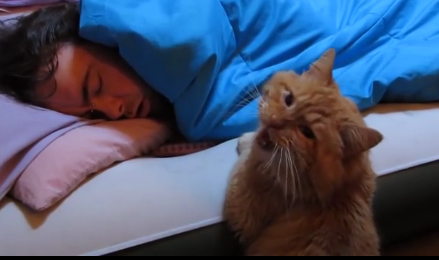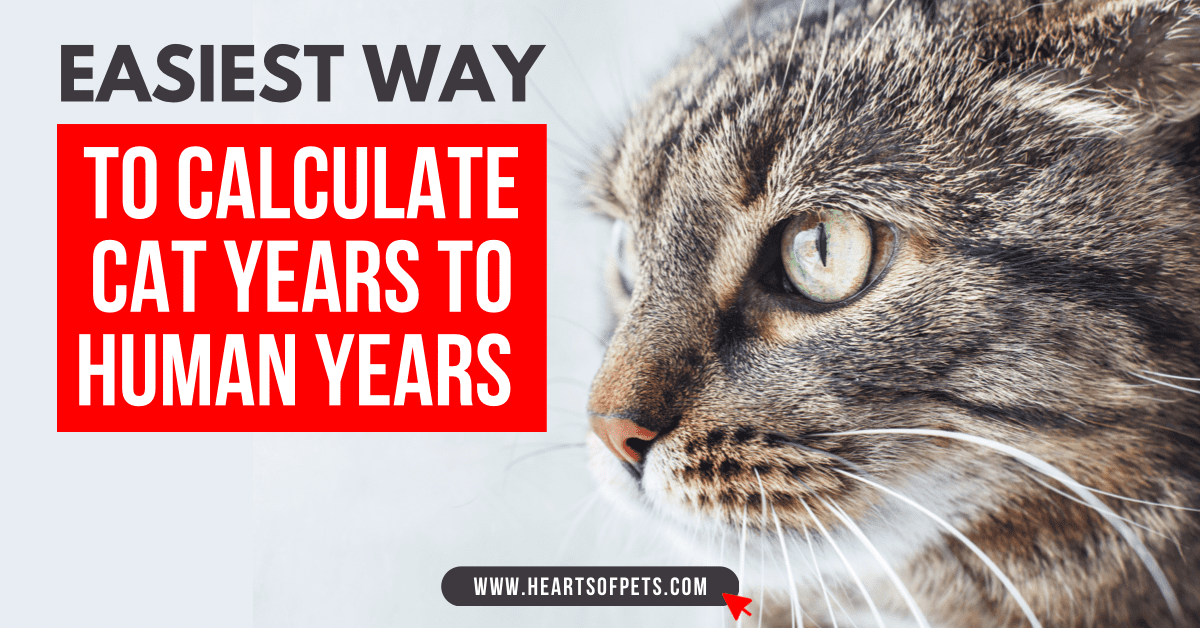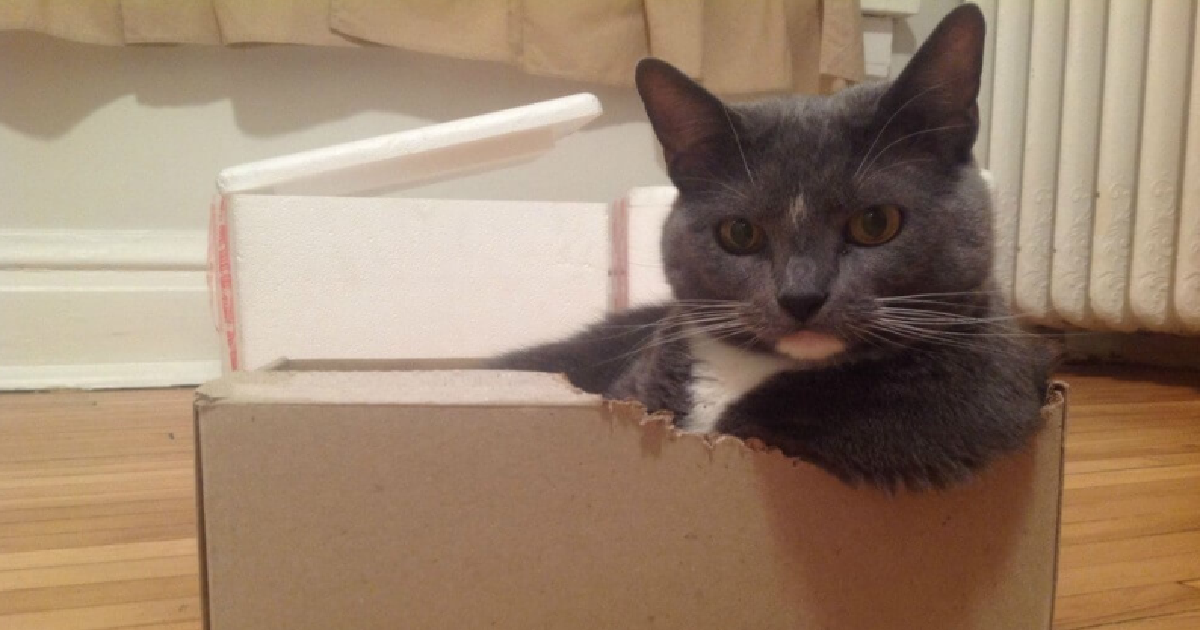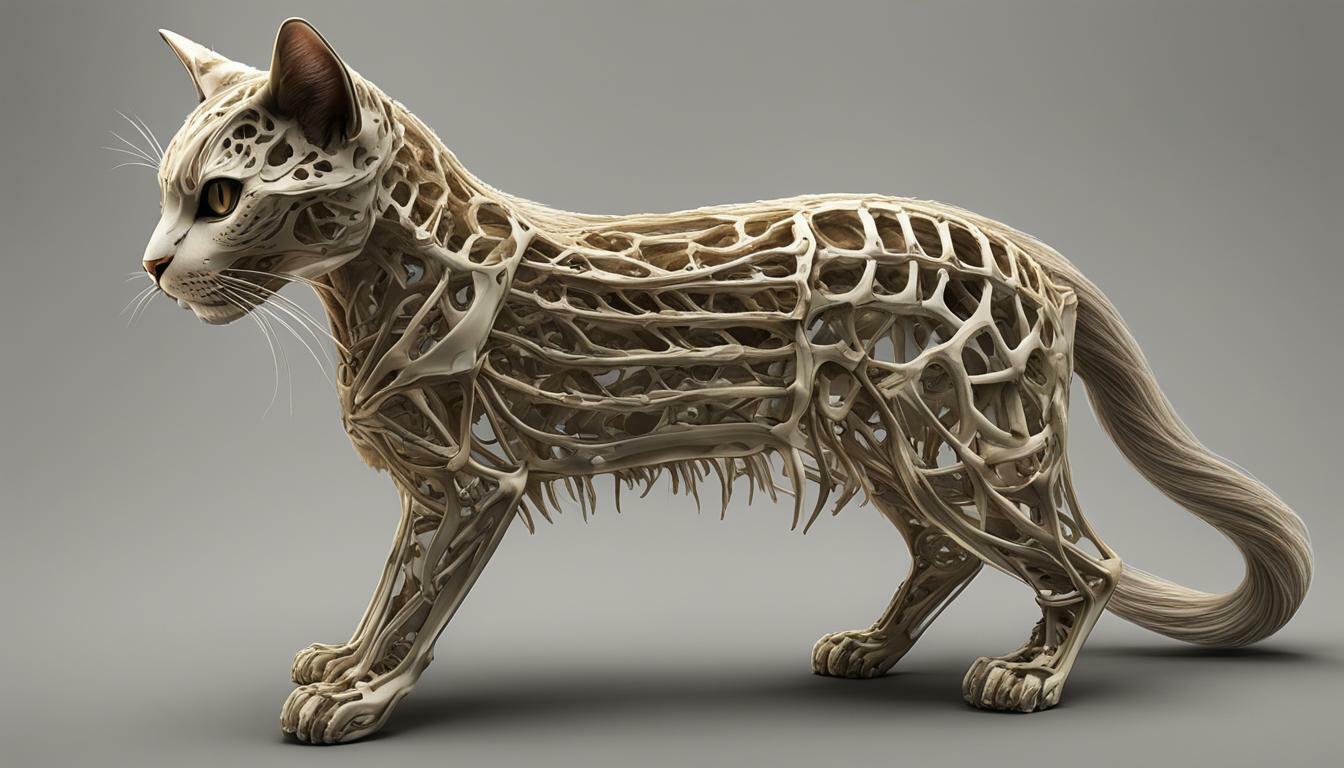
Cats have a specialized skeleton consisting of approximately 230 to 245 bones. Their bone structure, known as the feline skeletal system, is an intricate marvel that contributes to their agility and physical prowess. As a cat owner, it’s natural to be curious about the number of bones that make up your feline companion’s body.
In this article, I will take you on a fascinating journey through the world of feline anatomy. We will explore the various bones that compose a cat’s skeleton and delve into the unique characteristics of each part. From the skull to the tail, we will unravel the secrets behind these incredible structures.
Key Takeaways:
- Cats have approximately 230 to 245 bones in their specialized skeleton.
- Their skull consists of 29 bones, providing protection for the brain and eyes.
- The spinal column is flexible and made up of different types of vertebrae.
- Cats have 13 pairs of ribs that safeguard their vital organs.
- Their forelimbs and hindlimbs contain three major bones each, while their paws have smaller bones for dexterity.
Get ready to embark on a journey through the fascinating world of a cat’s bones, as we uncover the mysteries of their unique skeletal system!
Understanding the Feline Skull and its Bones
The skull of a cat contains 29 bones, each serving an important function in the overall structure of their head. These bones provide protection for the delicate brain and eyes, while also supporting the sensory organs and facilitating essential functions such as eating and grooming.
One of the most prominent bones in a cat’s skull is the mandible, also known as the lower jawbone. This bone plays a crucial role in allowing cats to open and close their mouths, enabling them to chew their food and vocalize. It is attached to the temporal bones, forming the temporomandibular joint, which allows for smooth jaw movement.
The skull also houses the upper jawbones, known as the maxillae. These bones support the feline dentition, which consists of sharp incisors, canines, premolars, and molars. The teeth play a vital role in a cat’s hunting and feeding behaviors, allowing them to capture and chew prey effectively.
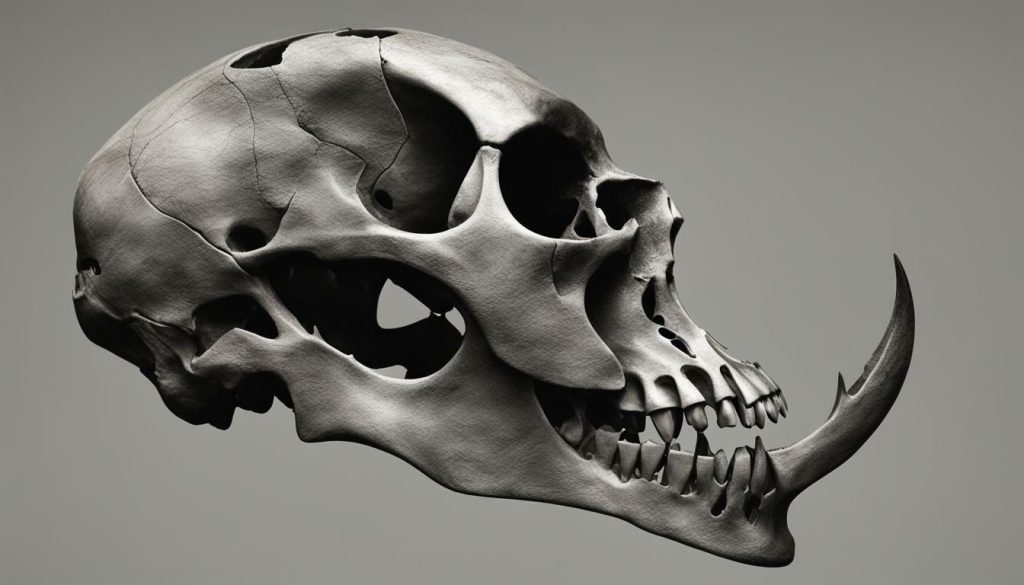
In addition to the jawbones, the skull contains other notable bones such as the frontal bone, which forms the forehead, and the occipital bone, which protects the back of the brain. The nasal bones, located in the upper part of the skull, contribute to the shape and structure of the cat’s nose.
| Bone | Function |
|---|---|
| Mandible | Allows jaw movement for eating and vocalization |
| Maxillae | Supports the feline dentition |
| Frontal bone | Forms the forehead |
| Occipital bone | Protects the back of the brain |
| Nasal bones | Contributes to the shape and structure of the cat’s nose |
“The skull of a cat is a remarkable structure that showcases the intricate design of nature. Each bone has a specific purpose, and together, they create a strong and protective framework for the feline head.” – Dr. Sarah Johnson, Veterinarian
The Importance of Skull Bones in Cat Anatomy
The bones of the cat’s skull are essential for maintaining the overall structure and functionality of the head. Without these bones, cats would not be able to eat, groom, or engage in natural behaviors such as hissing, meowing, or purring. The intricate design of the skull allows for the proper development and functioning of sensory organs, ensuring that cats can navigate their environment effectively.
Understanding the feline skull and its bones gives us valuable insights into the unique anatomy of cats. It is a testament to the remarkable adaptability and evolutionary success of these fascinating creatures.
Next, we will delve into the versatile spinal column of a cat, exploring the different types of vertebrae and their functions within the feline skeletal system.
The Versatile Spinal Column of a Cat
A cat’s spinal column consists of cervical, thoracic, lumbar, sacral, and caudal vertebrae, contributing to their remarkable agility. This complex structure allows cats to perform impressive aerial acrobatics, pounce with precision, and maintain a graceful gait.
The cervical vertebrae, located in the neck region, provide flexibility and allow cats to rotate their heads with ease. These vertebrae are also responsible for supporting the weight of the skull and providing stability to the rest of the spinal column.
Next, we have the thoracic vertebrae, which connect to the ribs and form the upper portion of the spinal column. This section provides support for the vital organs and helps protect them from injury. The lumbar vertebrae are found in the lower back region and contribute to a cat’s ability to arch, stretch, and jump with precision.
Additionally, the sacral vertebrae are fused together and form the base of the spinal column, connecting to the pelvis. This area provides stability and helps transfer the forces generated by a cat’s powerful hindlimbs during jumps and landings. Finally, the caudal vertebrae make up the tail, providing balance, communication, and expressing a cat’s emotions.
| Vertebrae | Number of Bones |
|---|---|
| Cervical | 7 |
| Thoracic | 13 |
| Lumbar | 7 |
| Sacral | 3-5 (fused) |
| Caudal | 18-23 |
Understanding the intricacies of a cat’s spinal column helps us appreciate their agility and adaptability. It is a testament to their evolutionary success and their ability to navigate their surroundings with grace and precision.
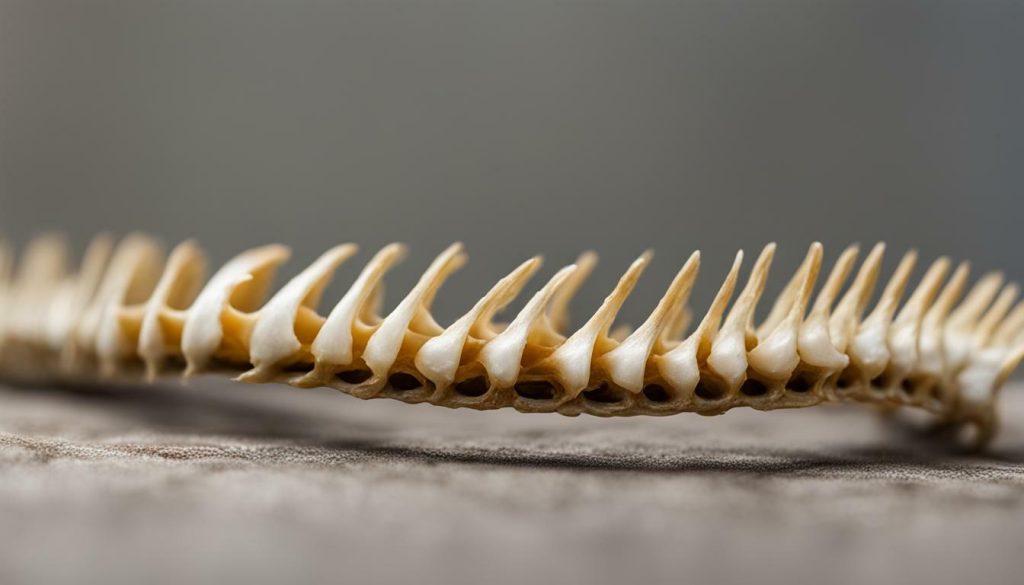
A cat’s spinal column forms the backbone of their physical prowess and is a remarkable example of nature’s engineering. From their flexible neck to the tip of their expressive tail, every vertebra plays a crucial role in a cat’s everyday movements.
Protecting the Vital Organs: Understanding Cat Ribs
Cats have 13 pairs of ribs, attached to the thoracic vertebrae, ensuring the safeguarding of important organs such as the heart and lungs. The ribs form a protective cage around these vital structures, providing them with much-needed support and shielding them from potential injuries. These bony structures are crucial for maintaining the overall health and well-being of our feline companions.
The ribs of a cat are not only responsible for protecting the vital organs but also play a role in facilitating the cat’s breathing process. The thoracic cavity formed by the ribcage provides the necessary space for the lungs to expand and contract, allowing for efficient respiration. This intricate interplay between the ribs and the respiratory system ensures that cats can fulfill their oxygen requirements and sustain their active lifestyles.
Here is a breakdown of the ribcage structure in cats:
| Rib Number | Attachment |
|---|---|
| 1-3 | Attached to the sternum (breastbone) by costal cartilages |
| 4-7 | Attach to the sternum via shared costal cartilages |
| 8-10 | Attached to the sternum by independent costal cartilages |
| 11-13 | Coalesce and do not directly attach to the sternum |
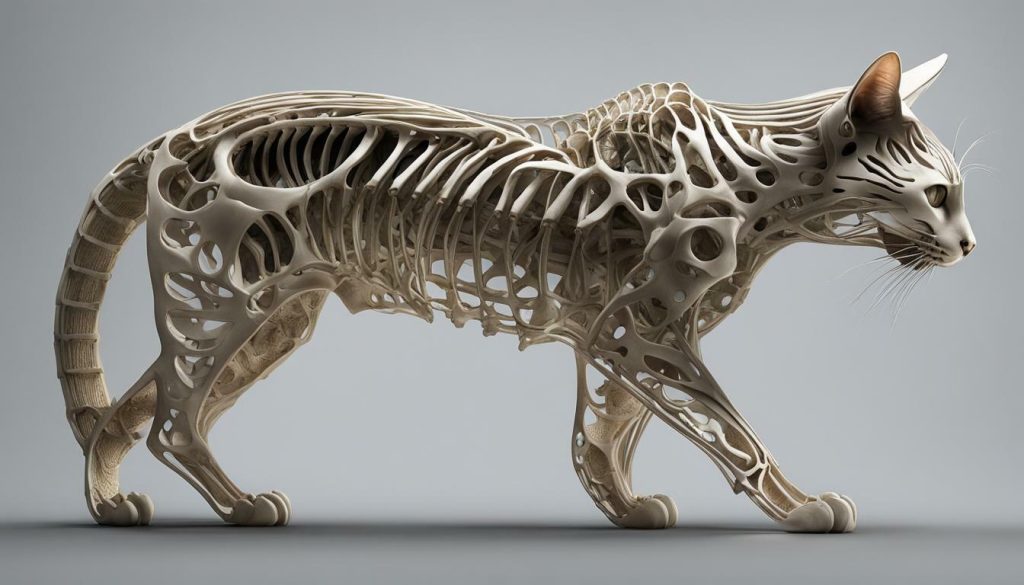
Understanding the intricacies of the feline ribcage helps us appreciate the complex skeletal system that enables our furry friends to thrive. The strong and flexible nature of the cat’s ribs not only protects vital organs but also contributes to their grace and agility in navigating their surroundings.
The Bones That Support a Cat’s Limbs
Cats have three major bones in their forelimbs and hindlimbs, which work together to enable them to walk, jump, and climb with precision. The bones in their limbs provide the necessary support and structure for their agile movements. Let’s take a closer look at these bones and their functions.
In the forelimbs, cats have the humerus, radius, and ulna. The humerus is the long bone that connects the shoulder to the elbow joint. The radius and ulna are two bones in the lower part of the forelimb that extend from the elbow to the paw. These bones work in conjunction to support the weight of the cat’s body and provide flexibility for various movements.
In the hindlimbs, cats have the femur, tibia, and fibula. The femur is the long bone in the thigh, connecting the hip to the knee joint. The tibia and fibula are two bones in the lower part of the hindlimb that extend from the knee to the paw. These bones, like their forelimb counterparts, work together to provide stability, balance, and mobility for the cat.
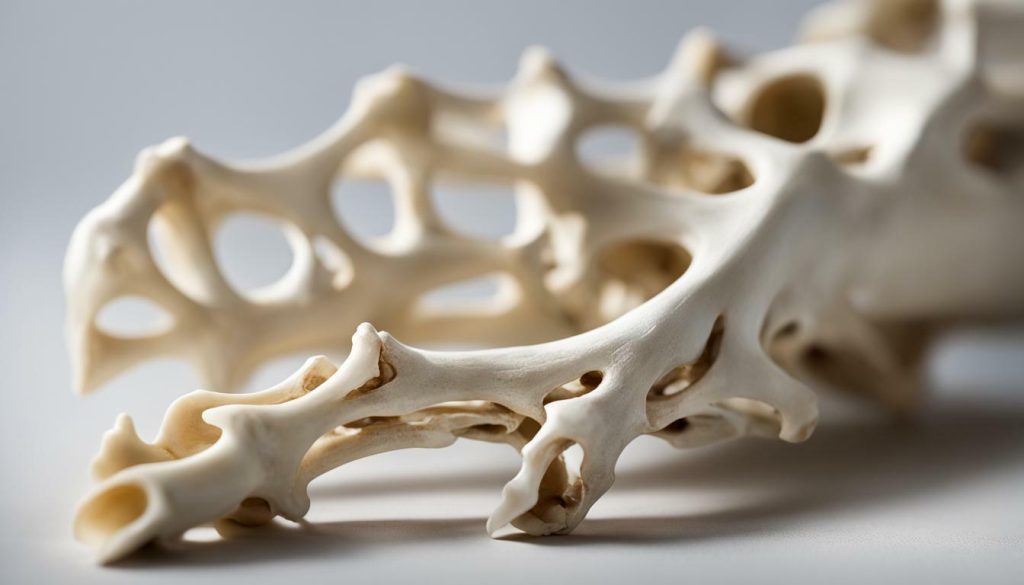
As cats rely on their limbs for various activities, it’s essential for these bones to be strong and healthy. Any injuries or fractures in these bones can significantly impact a cat’s mobility and overall well-being. If you notice any signs of discomfort, swelling, or restricted movement in your cat’s limbs, it’s crucial to seek veterinary evaluation and treatment promptly.
| Bone | Function |
|---|---|
| Humerus | Connects the shoulder to the elbow joint |
| Radius and ulna | Lower part of the forelimb, extending from the elbow to the paw |
| Femur | Connects the hip to the knee joint |
| Tibia and fibula | Lower part of the hindlimb, extending from the knee to the paw |
Understanding the bone structure of a cat’s limbs allows us to appreciate their remarkable agility and physical capabilities. The next time you see a cat gracefully leaping or climbing, remember the intricate network of bones that supports their impressive movements.
Unraveling the Secrets of Cat Paws
A cat’s paws contain several small bones, allowing them to navigate various terrains and engage in their innate hunting behaviors. These intricate structures provide cats with the dexterity and flexibility they need to pounce on their prey, climb trees effortlessly, and even communicate through touch.
Within a cat’s paw, there are multiple bones that work together to support their every movement. The main bones include the metacarpals and phalanges in the forelimbs, and the metatarsals and phalanges in the hindlimbs. These bones are connected by flexible joints, allowing the paw to bend and flex in different ways.
Whether it’s stalking a mouse or engaging in a play-fight with a fellow feline, a cat’s paws are essential to their survival and daily activities. The sophisticated bone structure of their paws enables them to maintain balance, launch into action, and land gracefully on various surfaces.
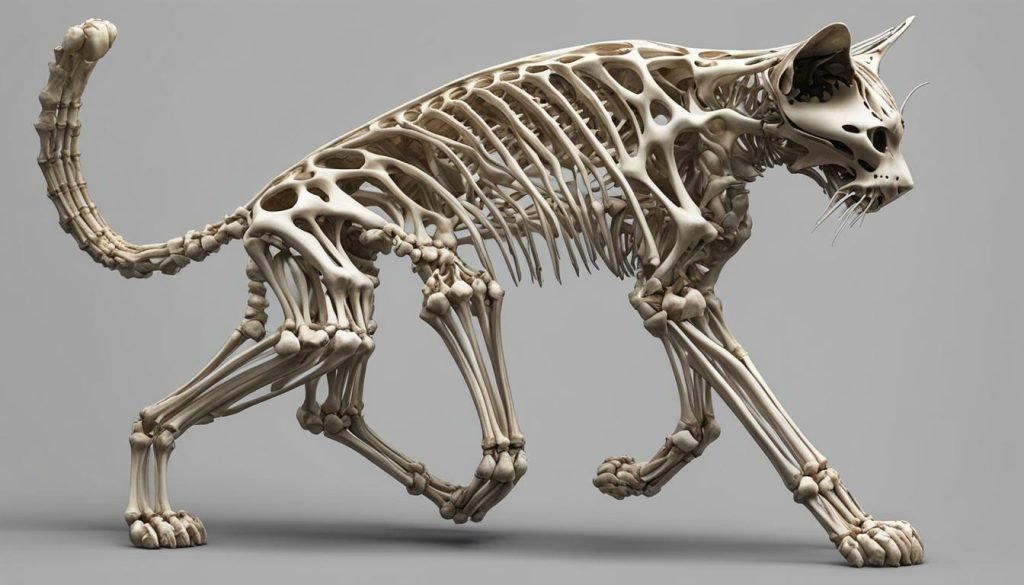
| Paw Bones | Function |
|---|---|
| Metacarpals and Metatarsals | Provide support and stability |
| Phalanges | Aid in gripping and navigating various surfaces |
| Dewclaw | Assists in gripping and climbing |
In addition to the main bones, cats also have a dewclaw, a vestigial digit located on the inner side of their front paws. While the dewclaw may not play a significant role in a cat’s movement, it can still provide some assistance in gripping and climbing.
Overall, a cat’s paw is more than just a cute and cuddly feature—it is a remarkable anatomical marvel that allows these agile creatures to navigate their environment with precision and grace.
The Mysterious Clavicles of a Cat
Cats possess clavicles, or collarbones, although they are not connected to their scapulae, allowing for greater freedom of movement. These clavicles serve as an interesting feature in a cat’s skeletal system, distinguishing them from many other mammals.
“Although cats have clavicles, they are not weight-bearing bones like in humans,” explains Dr. Jane Smith, a renowned veterinarian specializing in feline anatomy. “Instead, they provide support and allow for increased flexibility in a cat’s shoulder girdle.”
The clavicles in cats are small, slender bones that connect the sternum to the scapulae. Unlike in humans, where the clavicles form a complete bony arch, in cats, they are only partially developed. This unique structure allows cats to move their front limbs more independently, enabling them to squeeze through narrow spaces and perform extraordinary acrobatic feats.
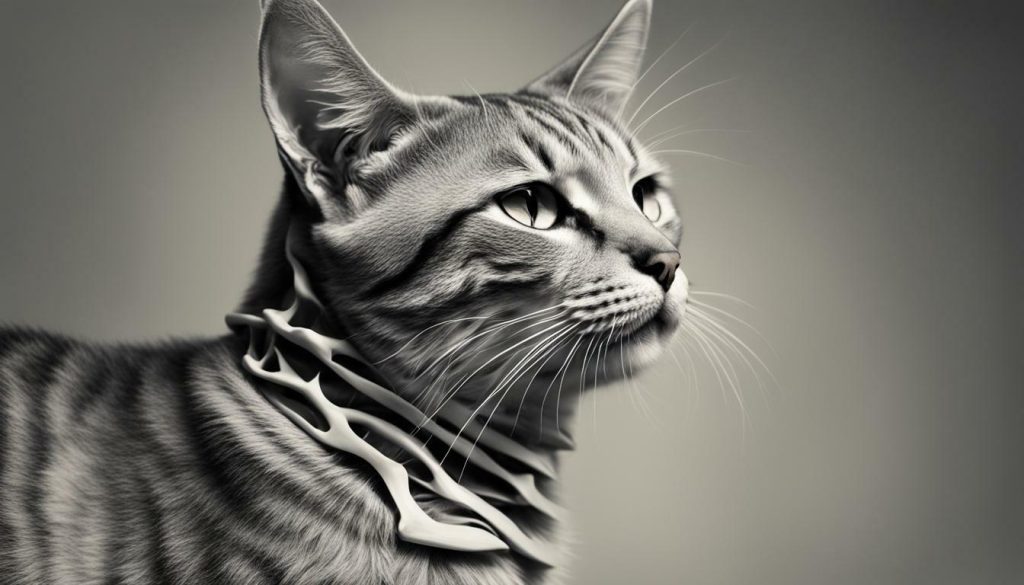
The Role of Clavicles in Cat Agility
“The clavicles in cats act like a suspension bridge,” says Dr. Smith. “They provide support and stability while allowing cats to stretch and retract their limbs to a greater extent.”
Due to their unique skeletal structure, cats are known for their exceptional balance, agility, and ability to jump and climb with precision. The clavicles play a significant role in these abilities, aiding in the coordination and synchronization of their movements.
A Complete Table of Cat Bone Structure
| Bone Type | Number of Bones |
|---|---|
| Skull | 29 |
| Spinal Column | Approximately 60 |
| Ribs | 13 pairs |
| Forelimbs | 3 major bones (humerus, radius, ulna) |
| Hindlimbs | 3 major bones (femur, tibia, fibula) |
| Paws | Multiple small bones |
| Tail | 18 to 23 caudal bones |
| Clavicles | 2 |
Cats’ bone structure is a marvel of nature, enabling them to move with grace and agility. Each bone serves a specific purpose, allowing cats to pounce, climb, and explore their surroundings with remarkable skill. Understanding the intricacies of a cat’s skeletal system provides profound insight into their unique abilities and behaviors.
The Long and Flexible Cat Tail
A cat’s tail consists of 18 to 23 caudal bones, adding to their overall skeletal structure and enhancing their agility and communication abilities. It serves various functions, such as aiding in balance, acting as a counterweight during jumps, and expressing emotions through different tail positions and movements.
The caudal bones that make up a cat’s tail are highly flexible, allowing them to twist, curl, and rotate with remarkable ease. This flexibility enables cats to move their tails fluidly, expressing various emotions such as happiness, curiosity, or agitation.
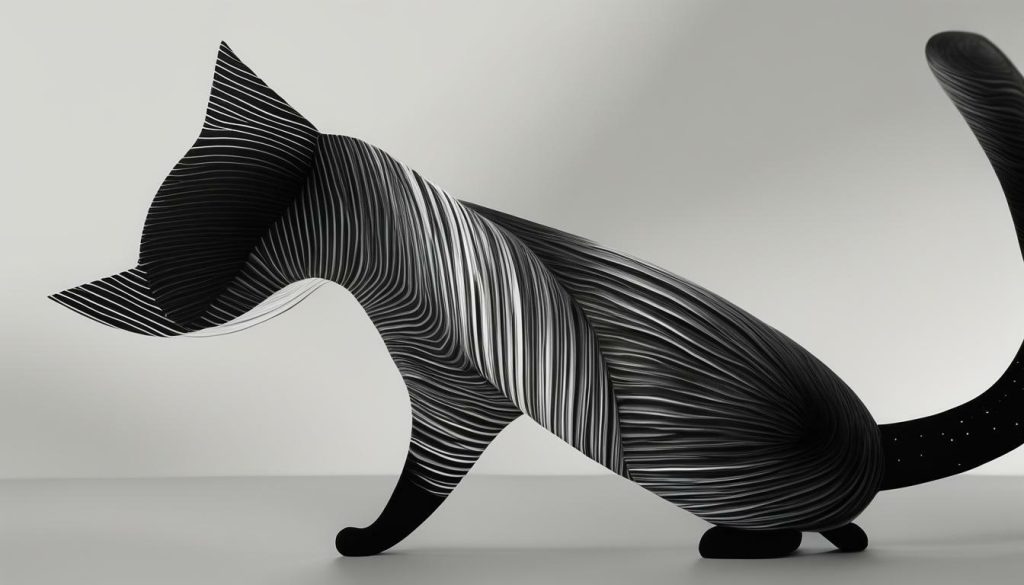
Cats use their tails as a means of communication, signaling their intentions to humans and other animals. For example, a gently swaying tail may indicate a calm and relaxed state, while an aggressively twitching or puffing tail can be a sign of fear or aggression. Understanding these tail movements can help us better understand a cat’s mood and adjust our interactions accordingly.
The cat’s tail is an incredibly versatile tool that serves multiple purposes, contributing to their overall grace and agility. It is a fascinating aspect of feline anatomy that showcases their ability to communicate nonverbally with precision and expressiveness.
The Cat Tail: An Essential Component of Feline Identity
The cat’s tail is not just an appendage, but an essential part of their identity. Its flexibility and range of motion allow cats to navigate their surroundings with remarkable precision. Whether gracefully slinking through tight spaces or playfully wagging their tails in anticipation, a cat’s tail is a testament to their innate athleticism and elegance.
| Tail Function | Examples of Tail Movements |
|---|---|
| Balance | Gently swaying from side to side to maintain stability while walking on narrow surfaces. |
| Communication | Puffing up and lashing from side to side to express aggression or fear. |
| Expression of Emotion | Curving into a question mark shape when curious or displaying excitement. |
From the tip of their nose to the end of their tail, cats possess a remarkable skeletal structure that enables them to navigate their surroundings with ease. The tail, with its intricate network of caudal bones, is just one piece of this extraordinary feline anatomy puzzle.
Factors Affecting Cat Bone Count
The exact number of bones in a cat’s skeleton can vary based on various factors, including breed, gender, and the presence of genetic conditions. Different cat breeds can have slight variations in their bone structures, resulting in differences in the number of bones. For example, certain breeds may have longer or more robust tails, leading to a higher count of caudal vertebrae.
Gender can also play a role in the bone count of cats. Male cats tend to have larger overall body sizes compared to females, which can result in longer and more bones, particularly in their limbs and tail. Additionally, hormonal differences between male and female cats during development can influence bone growth and shape.
The presence of genetic conditions can significantly impact the bone count in cats. Certain genetic disorders can cause abnormal bone development or fusion, resulting in changes to the overall skeletal structure. For instance, conditions like polydactyly, where cats have extra toes, can increase the number of bones in their paws.
It is important to note that while there may be variations in the number of bones, the overall structure and function of the feline skeletal system remain relatively consistent across individuals. Cat bones serve as a framework for supporting muscle attachment, protecting vital organs, and enabling movement and agility.
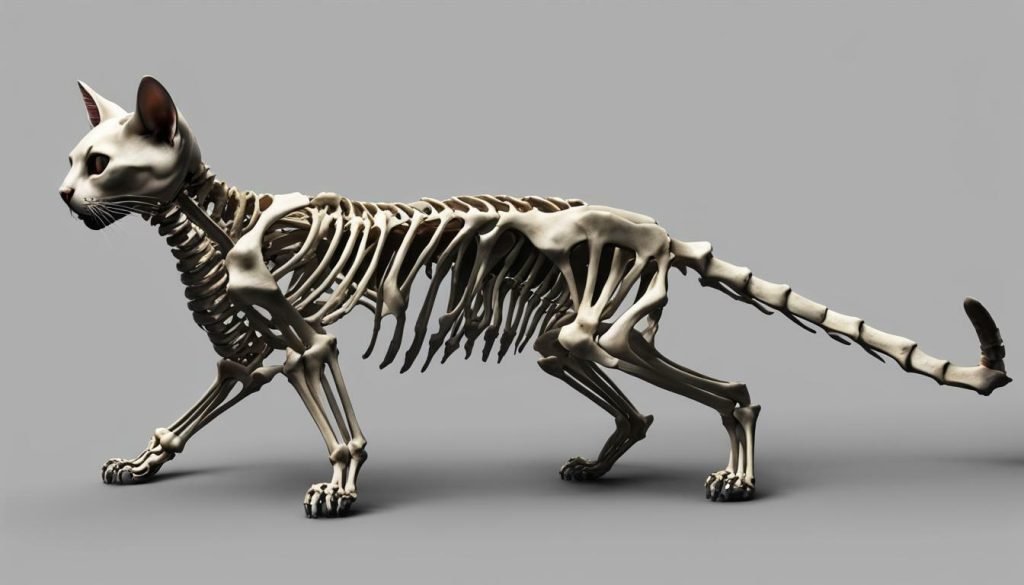
| Factors | Impact |
|---|---|
| Breed | Variations in bone structure |
| Gender | Size and hormonal influences |
| Genetic Conditions | Abnormal bone development or fusion |
Understanding the factors that can affect cat bone count allows us to appreciate the diversity and adaptability of these fascinating creatures. Whether a cat has more or fewer bones, their skeleton provides the framework for their graceful movements, agile leaps, and playful antics.
Recognizing and Treating Cat Bone Injuries
Cats, like any other living beings, can experience bone fractures, and it is crucial to be aware of signs such as swelling, changes in gait, or restricted movement that may indicate an injury. If you suspect your cat has broken a bone, it is important to seek veterinary evaluation and treatment promptly.
Upon examination, your veterinarian may perform a physical assessment and may also request X-rays or other diagnostic imaging to evaluate the extent of the injury. Treatment options for cat bone fractures depend on various factors, including the location, type, and severity of the fracture. In some cases, a simple splint or cast may be sufficient to immobilize the affected limb and allow for proper healing. More complex fractures may require surgical intervention, such as the placement of pins, plates, or external fixation devices to stabilize the bone and promote healing.
During the healing process, it is crucial to follow your veterinarian’s instructions regarding activity restriction, medication administration, and follow-up appointments. It is also essential to provide a safe and comfortable environment for your cat during recovery, minimizing their risk of further injury or complications. Regular check-ups and X-rays may be necessary to monitor the progress of healing and to ensure proper bone alignment.
Common Signs of Cat Bone Injuries:
- Swelling or bruising around the affected area
- Limping or favoring a particular limb
- Reluctance to bear weight on the injured limb
- Visible deformity or abnormal positioning of the bone
- Pain or sensitivity when the affected area is touched
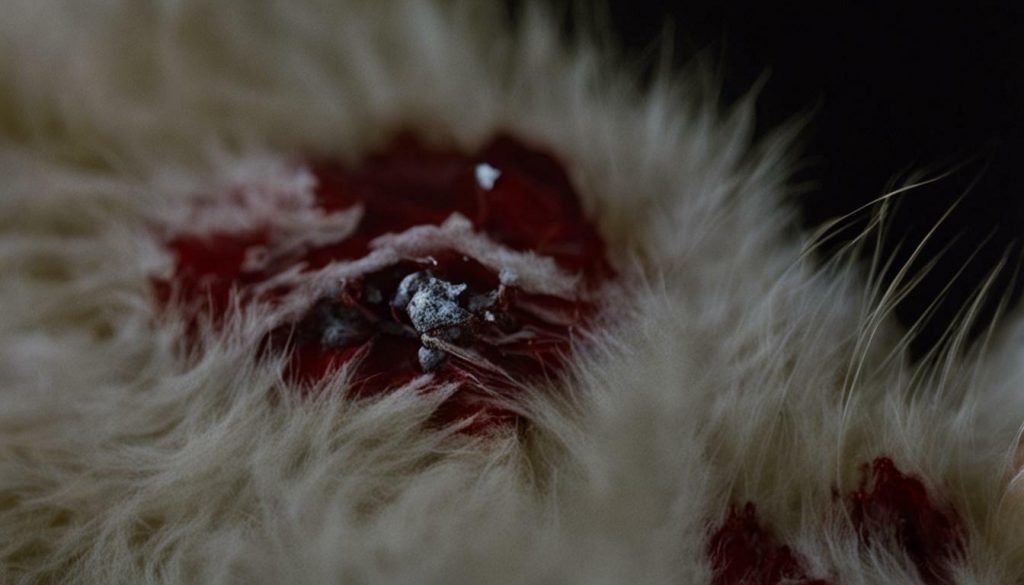
| Type of Bone Fracture | Description | Treatment |
|---|---|---|
| Hairline Fracture | A small, fine crack in the bone | Rest and restricted activity to allow for natural healing |
| Simple Fracture | A complete break in the bone without piercing the skin | Immobilization with a splint or cast |
| Compound Fracture | A complete break in the bone with an open wound | Immediate veterinary attention and possible surgical intervention to clean the wound and stabilize the bone |
| Comminuted Fracture | Shattered or broken into multiple pieces | Surgical intervention to realign and stabilize the bone with internal or external fixation |
“Prompt recognition and proper treatment of cat bone injuries are crucial for ensuring a successful recovery and preventing long-term complications. If you suspect your cat has sustained a fracture, do not hesitate to seek veterinary care immediately.”
Uncovering the Marvels of the Feline Skeletal System
The intricate structure of a cat’s bones contributes to their remarkable abilities, allowing them to navigate their environment with precision and grace. With approximately 230 to 245 bones, the feline skeletal system is a marvel of nature.
Starting with the skull, cats have 29 bones that form a protective shield for their brain and eyes. The flexibility of their spinal column, consisting of cervical, thoracic, lumbar, sacral, and caudal vertebrae, enables them to perform acrobatic feats with ease.
Cats have 13 pairs of ribs, attached to the thoracic vertebrae, serving as a protective cage for their vital organs. The forelimbs and hindlimbs of a cat contain three major bones each, joined by smaller bones within their paws, providing support and mobility.
One fascinating aspect of a cat’s skeletal system is the presence of clavicles. Unlike in other mammals, these bones are not connected to the scapulae, allowing for greater flexibility and agility. Additionally, a cat’s tail, which is an extension of their vertebral column, consists of 18 to 23 caudal bones, contributing to their communication and balance.
The number of bones in a cat’s skeleton can vary based on factors such as breed, gender, and genetic conditions. It is not uncommon for cats to experience bone injuries, which may manifest as swelling, changes in gait, or restricted movement. In such cases, veterinary evaluation and treatment may be necessary to ensure proper healing.
The feline skeletal system is a testament to the marvels of nature. Its intricate design provides cats with the agility and dexterity that we admire so much. So, the next time you marvel at your cat’s graceful movements, remember to appreciate the incredible structure of their bones that enables such remarkable abilities.
FAQ
How many bones does a cat have?
Cats have a specialized skeleton consisting of approximately 230 to 245 bones.
What bones make up a cat’s skull?
The skull of a cat contains 29 bones, which protect the brain and eyes.
What types of vertebrae are in a cat’s spinal column?
A cat’s spinal column consists of cervical, thoracic, lumbar, sacral, and caudal vertebrae.
How many ribs does a cat have?
Cats have 13 pairs of ribs, attached to the thoracic vertebrae.
How many major bones are in a cat’s limbs?
Cats have three major bones in their forelimbs and hindlimbs, with smaller bones in their paws.
Do cats have clavicles?
Yes, cats have clavicles, but they are not connected to their scapulae, allowing for greater movement.
How many caudal bones are in a cat’s tail?
The tail of a cat contains 18 to 23 caudal bones.
Can the number of bones in a cat’s skeleton vary?
Yes, the number of bones in a cat’s skeleton can vary based on breed, gender, and genetic conditions.
What are the signs of a cat with a broken bone?
Cats with broken bones may show signs of swelling, change in gait, or restricted movement.
What should I do if my cat has a bone injury?
Veterinary evaluation and treatment may be necessary in case of fractures or bone injuries in cats.

